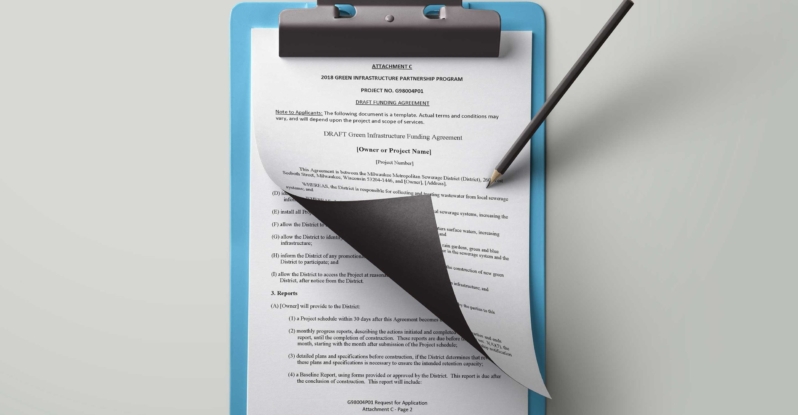Key Findings
- Interagency partnerships have been crucial in achieving the current success of the Green City, Clean Waters project.
- Green stormwater infrastructure is a much more economically, socially, and environmentally beneficial solution to stormwater management than other grey systems, such as storing water in tanks.
- The many projects that have been implemented in Philadelphia are innovative and replicable designs that could be utilized in many urban areas.
Organization description
The Philadelphia Parks and Recreation Department manages over 10,000 acres of public open space in Philadelphia as well as hundreds of structures and buildings. Programming expands far beyond just those locations that they manage. Philadelphia Parks and Recreation is one of the largest urban park and recreation systems in the world, created through the merger of the Fairmount Park Commission and the Philadelphia Department of Recreation. The Philadelphia Department of Parks and Recreation focuses on improving the city’s environmental, economic, social, cultural, historic and physical health. Besides running programs and the general upkeep of the park system, Philadelphia Parks and Recreation has a few key construction projects that include work on the Baxter Trail, Port Richmond Trail and a gap analysis of the Schuylkill River at the Wissahickon Gateway.
The Philadelphia Water Department provides integrated water, wastewater, and stormwater services to the Greater Philadelphia area, through safe drinking water, a reliable water supply for all communities, housing and commercial needs, and a cleaner watershed.
Program description
Philadelphia is one of the most urbanized cities in the United States. This urbanization has altered the water cycle and compromised the water quality of the city. The Philadelphia Water Department designed a unique stormwater management plan to combat this waning water quality, called Green City, Clean Waters. Green City, Clean Waters is designed to provide many social, economic, and environmental benefits for the city of Philadelphia along with providing stormwater management. The Philadelphia Water Department partnered with the Philadelphia Parks and Recreation Department, and the interagency partnership has implemented this project throughout the city.
Philadelphia has a combined sewer system and is required by the Environmental Protection Agency (EPA) to fix the system when excess wastewater is dumped directly into rivers and streams during significant rainfall. Currently, 48% of the city in four different watersheds is within the combined sewer system drainage areas. Other cities with combined sewer systems are all required by the Clean Water Act (issued by the EPA) to fix this problem as well.
The city of Philadelphia is addressing this issue in a unique way: through green stormwater infrastructure. Philadelphia plans to spend $2.4 billion over 25 years to capture over one-third of the city’s stormwater from impervious surfaces.
“Green stormwater infrastructure comprises a range of soil-water-plant systems that intercept stormwater, infiltrate a portion of it into the ground, evaporate a portion of it into the air, and in some cases slowly release a portion of it back into the sewer system. By capturing stormwater close to where it lands, GSI keeps runoff out of underground pipes, thereby ensuring polluted water does not end up in creeks and rivers.” (www.parksandrecreation.org/2013/July/Greener-Parks-for-Cleaner-Waters).
Green City, Clean Waters, through its extensive partnerships, emphasizes a sustainable approach and is attempting to energize the citizens of Philadelphia about its unique way of maintaining one of the oldest water infrastructure systems in the United States. Green City, Clean Waters’ approach focuses on “utilizing rainwater as a resource by recycling, re-using, and recharging long neglected groundwater aquifers rather than piping it away from our communities into our already stressed tributaries.”
The key partnership between the Philadelphia Water Department and the Philadelphia Parks and Recreation in Green City, Clean Waters is critical because public lands are prioritized in the program. Both departments hope that Green City, Clean Waters will not only create innovative designs, but replicable ones. The Green2015 Plan from the Philadelphia Parks and Recreation Department is vital to the Green City, Clean Water Initiative. The main goal of that plan is to add 500 acres of new public green space to the city of Philadelphia by 2015. These new sites will integrate green stormwater infrastructure into the park, providing recreational areas that also manage stormwater runoff.
Program goals/issues addressed
- Large-scale implementation of green stormwater infrastructure to manage runoff at the source on public land.
- Large-scale street tree program to improve stormwater management and appearance.
- Convert vacant/abandoned land to public open space and responsible redevelopment.
- Restore streams back to healthy aquatic habitats.
- Approach the water quality requirements of the Clean Water Act and the Pennsylvania Clean Streams law.
- Reduce the amount of impervious watershed hardscapes.
- Maximize program benefits through public and private partnerships.
Timeframe (planning/execution)
Green City, Clean Waters is a 25-year project, but the benefits of the program will extend far beyond that timeframe.
Annual program budget
Green City Clean Waters plans to spend $2.4 billion on capital construction, operating and maintenance costs over a 25-year period. A current commitment of $125 million is being put toward stream restoration and wetlands creation.
Funding sources/partnerships and type of support provided
Philadelphia city agencies and partners: Streets Department, Mayor’s Office of Sustainability, Planning Commission, Office of Housing and Community
Results achieved/impact
- Within two years of the beginning of the project, 172 stormwater tree trenches, 25 stormwater bump-outs, 48 rain gardens, 50 porous paving sites, and 132 other green stormwater infrastructure projects have been constructed or are in the design or construction phase.
- The Philadelphia Water Department was one of six recipients awarded the 2012 US Water Prize, presented by the Clean Water America Alliance.
- In 2012, the Philadelphia Water Department won the Pennsylvania Horticultural Society’s Sustainability Award for their flower show demonstration of the plans for Green City, Clean Waters.
- In 2011, Philadelphia achieved Emerald City Status, the only city to do so out of 15 cities assessed by Rooftops to Rivers that are implementing green infrastructure to combat stormwater management problems.



